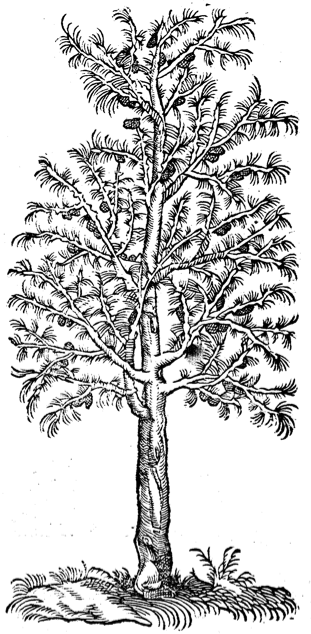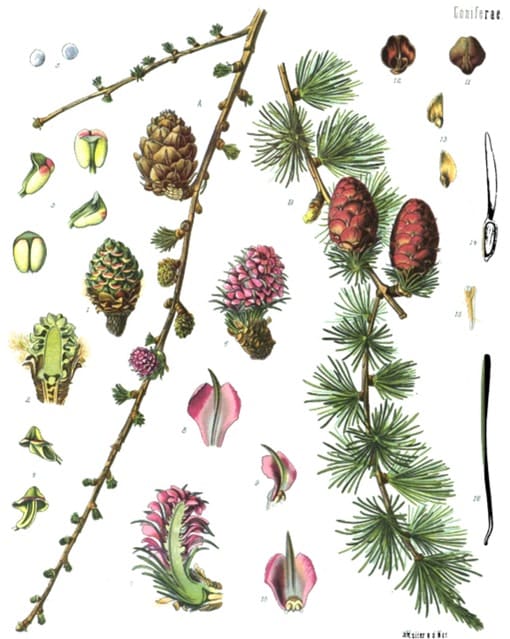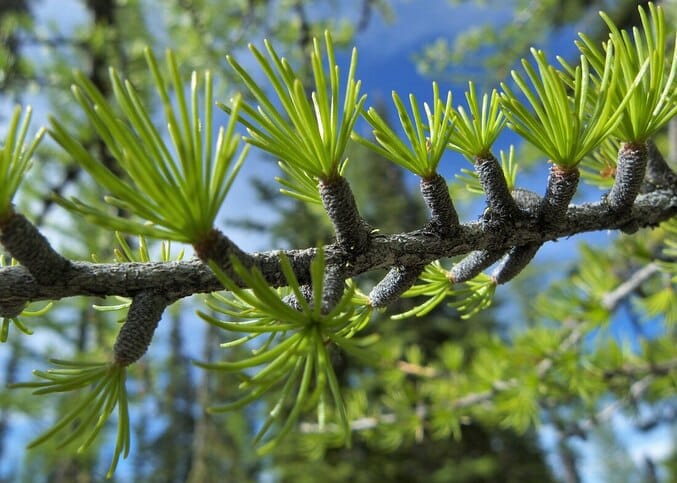Terebinth Laricea, Venice Turpentine
Terebinthina Veneta, Pini Laricis Terebinthina Dioscorides Materia Medica, Mathias, 1563
Dioscorides Materia Medica, Mathias, 1563 Koehler’s Medizinal Pflanzen, 1887
Koehler’s Medizinal Pflanzen, 1887 Larix occidentalis
Larix occidentalis(Photo by Thayne Tuason) (Wikimedia)
Botanical name:
Larix occidentalis (Western Larch) (syn. L. europea, Pinus larix)
Parts used:
Turpentine collected by tapping the tree in Spring or Autumn.
This is thinner than other Turpentines, thicker than oil, but thinner than Honey.
Temperature & Taste:
Warm, dry. Bitter
Uses:
1. Clears Damp, Promotes Urine:
-Edema
-Kidney pain
-prevents Stones
-Leukorrhea
-Spermatorrhea, Gonorrhea
2. Moves the Blood, Resists Poison, Promotes Healing:
-Hematuria, bloody or purulent Urine from Ulcers or Abscess of the Kidney or Bladder
-Ulcers of the Lungs, Kidneys, Bladder, Bowels
-Resolves and Ripens Abscesses
-commonly used in ointments and plasters to move the Blood, promote Healing and relieve Pain.
3. Clears Phlegm, Stops Cough:
-Cough, Asthma
-was recommended by some for Pleurisy
4. Externally:
-often used in plaster for its penetrating nature
-resolve hardness and tumors
-Arthritic pain
-suppressed Urine (injected into the bladder)
-Dysentery or Ulcers of the Intestines, given in Enemas
Dose:
Spirit of Venice Turpentine: 3 drops in wine to promote Urine
Substitutes:
1. Salmon said the ‘native Resin of the Fir Tree’ in its liquid form is the ‘Venice Turpentine’ of the shops. It appears to have been used synonymously with the Turpentine of the Larch, even since the time of Galen.
2. A number of sources have stated that the Venice Turpentine of the shops was most commonly artificial, prepared from a mix of equal parts of Resin and Oil of Turpentine. The primary difference with Venice Turpentine being its more liquid nature, and this compound produces a resin of similar consistency.
Preparation:
For internal use, it was usually washed in water. Take water and Venice Turpentine, shake well, then separate the water. This can also be achieved by distilling water. Sometimes it was washed with a suitable water such as Rose water.
Main Combinations:
1. Hematuria, make pills with Venice Turpentine and Mastic (Wirtzung)
2. Spermatorrhea, Venice Turpentine with Bistort, Tormentil, Water Lily root, Lettuce seed, Rue seed, Agnus Castus, Amber, Mastic (Lemery)
3. Gonorrhea:
i. Venice Turpentine (half oz.), distilled Oil of Nutmegs (1 drop), White Wine (4 oz.), Yolk of one egg, Syrup of Marshmallows (1 oz.), mix for a dose. (Pharmacopœia Bateana, Salmon, 1713
ii. Camphor (2 drams), Venice Turpentine (2 oz.), Dragons Blood (3 drams), form pills. Dose: half dram. (A Treatise on Foreign Drugs, Geoffroy and Thicknesse, 1749)
4. Diuretic:
i. Venice Turpentine with Lemon juice in White Wine
5. Asthma or Suppression of Urine Venice Turpentine (2 drams), Oil of Sweet Almonds (half oz.).
6. Poor or blurry vision from Heat, form pills with Venice Turpentine, Aloes, Cubeb, Cardamon, Pepper (Wirtzung)
7. Ulcers of the Lungs, Kidneys or Bladder:
i. Venice Turpentine (1 ½ drams), Licorice root, sufficient to make a Bolus. (A Treatise on Foreign Drugs, Geoffroy and Thicknesse, 1749)
8. Swellings and Tumors:
i. Venice Turpentine with Bittersweet, Dautra leaf, Deadly Nightshade, Yellow Dock root, Poke root
ii. Myrrh, Olibanum, Mastic, Galbanum, Elder flower, Fennel seed, Fenugreek, Marshmallow, Comfrey, Turmeric, made into a plaster with Wax, Resin, Venice Turpentine, Oil of Linseed, adding Spirit of Turpentine towards the end. (Pharmacopoeia Generalis, 1783)
9. Leukorrhea, Rhubarb powder, Venice Turpentine sufficient to form a Bolus. (A Treatise on Foreign Drugs, Geoffroy and Thicknesse, 1749)
10. Tumors of the Uterus:
i. make an ointment with Venice Turpentine, Wax and Olive oil (Wirtzung)
11. Wounds:
i. mix Venice Turpentine with Egg Yolk and Oil of Roses
ii. mix Venice Turpentine with Oil of St. Johns wort and Wax (Pharmacopoeia Wirtembergica, 1798)
iii. Venice Turpentine with Oil of St. Johns wort, Egg Yolk, Tincture of Aloes, Tincture of Myrrh (Pharmacopee Usuelle, Louvain, 1821)
iv. Venice Turpentine, Licorice, Yarrow (1 dram each), Mastic, Olibanum (half dram each). Dose: 10–20 grains.
12. Bruises, Ulcers, gangrene:
i. Wax (half pound), Olive oil (1 pound); melt, keep over fire for an hour with Red Sandalwood (2 oz), then add Venice Turpentine (1 lb.). Express strongly, when nearly cold add Camphor powder (2 drams). Stir until cold. (Pharmacopee Usuelle, Louvain, 1821)
ii. Red Wine, Olive Oil (3 lbs. each), Yellow Wax, Rose Water (half pound each), Red Sandalwood (2 oz.). Boil half an hour, stirring, then add Venice Turpentine (1 lb.), mix well, and when nearly cold add Camphor powder (2 oz.). (Formulaire Magistral et Memorial Pharmaceutique, 1823)
13. Enema:
i. Venice Turpentine (4–6 drams), dissolve it with the yolk of an Egg and add to 1 pound of Whey or a suitable decoction (such as Camomile, Linseed, Fenugreek)
Cautions:
1. Not used internally in fever or inflammation without first bleeding or purging.
Main Preparations used:
1. Plaster base:
i. Oil (Linseed, Olive, Sesame etc.) (9 oz.), Wax (6 oz.), Venice Turpentine (6 drams), altering the Oil to give a thinner or thicker texture as require. To this can be added Oils, Powders, Gums, camphor, Spirit of Turpentine etc.
ii. Resin, Wax (1 part each), Venice Turpentine, Lard (2 parts each)
iii. Wax (8 parts), Venice Turpentine (3 parts), Olive oil (5 parts), Mastic or Frankincense (2 parts)
iv. Wax (10 oz.), Venice Turpentine (4 oz.), Olive oil (half pound)
v. Resin (12 parts), Wax (4 parts), Venice Turpentine (18 parts)
2. Ointment base:
i. Venice Turpentine, Olive oil (equal parts), Wax (half part).
ii. Venice Turpentine, Wax (2 parts), Lard (6 parts)
- Extra Info
- History
|
‘The turpentine of the larch was known to Dioscorides as imported from the Alpine regions of Gaul. Pliny also was acquainted with it, for he correctly remarks that it does not harden. Galen in the 2nd century also mentions it, admitting that it may well be substituted for Chian turpentine, the true, legitimate Terebinthina. Yet even in the beginning of the 17th century many pharmacologists complained of such a substitution. Mattioli gave an account of the method of collecting it about Trent in the Tirol, by boring the trees to the centre, which is true to the present day. It used formerly to be exported from Venice, then the great emporium for drugs of all kinds; the turpentine may |
even at times have been collected in the territories of the Venetian republic. We find it expressly called Terebinthina Veneta by Guintherus of Andernach. The name larch seems to belong to the turpentine rather than to the tree. Dioscorides says the resin is called by the natives [?], and a similar name is mentioned by Galen. In Pasi’s Tariffa de pesi e misure, 1521, we find ” Termentina sive Larga,”— and larga is still an Italian name for larch turpentine. The peasants of the Southern Tirol call it Lerget, and in Switzerland the common name in German is Lortsch. (Pharmacographia, Fluckiger & Hanbury, 1879) |
